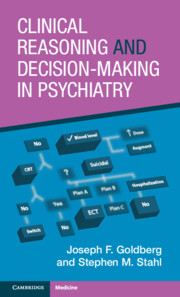Book contents
- Clinical Reasoning and Decision-Making in Psychiatry
- Reviews
- Clinical Reasoning and Decision-Making in Psychiatry
- Copyright page
- Contents
- Foreword
- Preface
- 1 Making Sense of the Senseless: How to Gather and Organize Pertinent Information
- 2 The Approach to Diagnostic Ambiguity
- 3 What the Patient Isn’t Telling You: When Seeing Is Not Believing
- 4 Shared Decision-Making
- 5 Deciding on Appropriate Treatment Modalities: Medication, Psychotherapy, Hospitalization, and Other Levels of Care
- 6 Measurement-Based Care and Applying Statistical Concepts to the Individual Patient
- 7 Hypothesis-Testing and Crafting Patient-Specific Decision Trees
- 8 Decision Points in Iterative Pharmacotherapy
- 9 Hierarchical and Complex Pharmacotherapy Decision-Making
- 10 Prioritizing the Components of Any Decision-Making Model
- Index
- References
1 - Making Sense of the Senseless: How to Gather and Organize Pertinent Information
Published online by Cambridge University Press: 25 March 2024
- Clinical Reasoning and Decision-Making in Psychiatry
- Reviews
- Clinical Reasoning and Decision-Making in Psychiatry
- Copyright page
- Contents
- Foreword
- Preface
- 1 Making Sense of the Senseless: How to Gather and Organize Pertinent Information
- 2 The Approach to Diagnostic Ambiguity
- 3 What the Patient Isn’t Telling You: When Seeing Is Not Believing
- 4 Shared Decision-Making
- 5 Deciding on Appropriate Treatment Modalities: Medication, Psychotherapy, Hospitalization, and Other Levels of Care
- 6 Measurement-Based Care and Applying Statistical Concepts to the Individual Patient
- 7 Hypothesis-Testing and Crafting Patient-Specific Decision Trees
- 8 Decision Points in Iterative Pharmacotherapy
- 9 Hierarchical and Complex Pharmacotherapy Decision-Making
- 10 Prioritizing the Components of Any Decision-Making Model
- Index
- References
Summary
The core foundation of excellent psychiatric treatment starts with obtaining a coherent history, preferably as a longitudinal narrative that follows a chronological timeline, with an emphasis on parsing relevant pertinent “positives” and “negatives” from that narrative. A simple organizing principle is to have patients present their concerns from a chronological perspective, in order for the clinician to develop a clear narrative. “When was the very first time you recall having any problems involving your mental health?” provides a good starting point, followed by “When was the first time you sought any kind of treatment for those problems?” A chronologically organized narrative gives some sense not only about the backdrop and longevity of a psychiatric disorder but, moreover, clues about the degree of distress and disruption caused by symptoms, the potential duration of untreated illness, and symptom severity as reflected by the kinds of interventions that previously occurred. A clinical timeline that starts with years of psychotherapy differs from one that begins with an involuntary psychiatric hospitalization or a suicide attempt; low-grade symptoms that persist for extended periods unnoticed by others, or cause no outward functional impairment, imply a different level of severity and debilitation, and possible prognosis, from those linked with more obvious outward signs of disability. For persistent problems, one always wonders why the patient is seeking help now and not a week or month or two ago.
- Type
- Chapter
- Information
- Clinical Reasoning and Decision-Making in Psychiatry , pp. 1 - 25Publisher: Cambridge University PressPrint publication year: 2024



